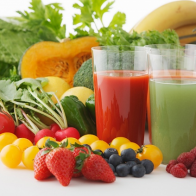 For some health enthusiasts, fermented foods are a crucial element of the diet. From raw sauerkraut, pickles, rejuvelac, sprout milk yogurt, raw miso, nut “cheese”, and raw soy sauce, these fermented foods add a new element to a seemingly straightforward raw food diet. They add a sassy flavor profile to the oftentimes neutral flavors of fruits and vegetables. But what exactly are fermented foods, and what do they contribute nutrionally? Despite their profound health benefits, fermented foods are not for everyone. Before exploring the fermented food group, understand its uses and learn how to ferment the right way.
For some health enthusiasts, fermented foods are a crucial element of the diet. From raw sauerkraut, pickles, rejuvelac, sprout milk yogurt, raw miso, nut “cheese”, and raw soy sauce, these fermented foods add a new element to a seemingly straightforward raw food diet. They add a sassy flavor profile to the oftentimes neutral flavors of fruits and vegetables. But what exactly are fermented foods, and what do they contribute nutrionally? Despite their profound health benefits, fermented foods are not for everyone. Before exploring the fermented food group, understand its uses and learn how to ferment the right way.
It is easy to confuse the word “fermented” with its common associations. The word “fermented” does not denote yeast-based foods; instead, it refers to only lacto-bacillus (Acidophilus) based fermented foods. Yeast-based fermentation includes such toxic substances like alcohol, which is neither health-facilitating nor relevant to this discussion. Lacto-bacillus based fermented foods, on the other hand, are health foods.
Benefits:
- Increases good intestinal bacteria
- Increases the digestibility of foods
- Produces antibiotic and anti-carcinogenic substances
- Preserves fruits and vegetables
- Rich in probiotics, enzymes and minerals
- Adds complex taste to the diet
Drawbacks:
- Highly acidic
- Hard to find fresh, quality fermented foods—fine line between “living” and “dead”
- Easy to overeat because of taste
Fermented foods increase the amount of healthy bacteria in the intestines, ultimately improving digestion and contributing to a more efficient system. Because these foods are fermented, however, they are acidic by nature and can cause more harm than good if they do not encourage elimination. The best way to see if fermented foods are right for you is to test them on yourself. Preparing your own fermented foods ensures they are fresh and removes the mystery of the process.
DIY: Fermenting Foods
The process of fermenting your own vegetables is far less intimidating than you think. While recipes will change with regard to how they flavor and nuance fermented vegetables or fruits, the basic template remains the same.
Step 1: Start off by shredding, pounding or mashing the fruits and/or vegetables of your choice to encourage the release of their natural juices.
Step 2: In a mason jar, layer the fruit and/or vegetables atop one another, sprinkling unrefined sea salt between the layers and pressing them down with a wooden spoon or mallet to encourage the fruits and/or vegetables to release more of their juices. The extraction of juice from the fermenting foods is important, as the salt and the juice together will act as brine for the production of good bacteria.
Step 3: Leave a 1-inch space between the top of the Mason jar and the fruits and/or vegetables in the Mason jar. Seal the jar and let sit at room temperature for 3 to 4 days.
Step 4: When the fruits and/or vegetables are ready (you can taste-test them to figure this out—you will be able to tell if the batch is bad), store the finished product in the refrigerator
And that’s all there is to it!
You can ferment just about any fruit and vegetable, so have fun exploring the options, combining certain foods with others and adding a touch of creativity with your choice of spices.







In washington state we have OLYKRAUT (http://olykraut.com). Some super duper rad folks who make some really yummy fermented foods that you can get at the farmers market, coops or from going to a workshop or worktrade with them! I never thought id eat stuff like this but its awesome! Local artist Nikki McClure does the labels even!